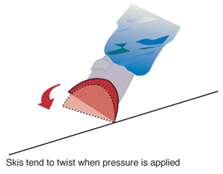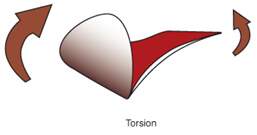
A GUIDE TO SKI TECHNOLOGY
With so much technology going into skis it can be hard to keep up with all the terminology and its purpose, so we’ve created this handy guide to give you a breakdown of all the tech.
Please remember it’s only for information purposes; any binding mounting or adjustments should be made by a professional ski technician.
- Sidecut
- Waist width
- Turn radius
- Self-steering
- Effective edge
- Rocker type
- Binding mounts
- Ski flex
- Torsional stiffness
Sidecut
When viewed from above, side cut refers to the shape of the ski. Today’s modern skis have much more Side Cut than earlier models, and this bowtie shape helps the ski turn. In general terms, the more pronounced the side-cut the easier the ski will turn.

Waist width
The width of your skis will contribute to how it feels and performs. The measurement is taken from the middle of the ski, usually at the narrowest point. Narrow widths will offer a quicker turn, while wider waist widths offer better flotation in powder.
Ski dimensions will be given in a 3-number format; tip, waist, and tail.
Turn radius
The turn radius will also contribute to how your skis feel and perform. The turn radius is given in metres. The narrower the ski’s width in relation to its tip and tail indicates a shorter turn radius and deeper sidecut.
- Skis with a shorter turn radius are suitable for all mountain and some powder skis with tapered tips and tails. Carving skis often have a shorter turn radius and are good for quicker turns.
- A medium turn radius is good for all mountain riding, park, and pipes.
- Skis with a long turn radius are good for powder and big mountain skiing, turning more slowly and usually more stable at high speeds.
Self-steering effect
The self-steering effect occurs on all skis but is much more evident on skis with a large side cut. As the ski moves forward while on edge, the tip of the ski naturally engages the snow and begins to flex along the length of the ski and alter the direction of travel.
All skiers use the self-steering effect to control their speed and direction whether the turns are skidded or carved. Choosing a ski with a more pronounced side cut will have a greater self-steer making it more suited to piste skiing where speed control is necessary. In deeper snow or varied conditions, the self-steer effect is still present, but with the varied snow skiers can be less worried about the carving ability of the ski.
Effective edge/contact length
The effective edge is the amount, or length of edge, that is in contact with the snow when tilted on its side. The amount of ski edge that is in the snow is one of the factors that will affect the size and type of turn.
Contact length is similar, but instead refers to the length of base material that is in contact with the snow.
Rocker type

CAMBER
Traditionally skis are cambered, giving them an upward arching curve in the middle to help distribute pressure evenly across the length of the skis. Cambered skis ask for a more precise turn but give maximum energy on groomed pistes and hard snow, as well as good edge hold and pop.
Camber is often preferred by racing skiers and advanced park riders.
ROCKER
A rocker, also known as reverse-camber, is a camber turned upside down. Ideal for both beginner and advanced riders, the rise of the tip and tail away from the snow results in easier float in deeper powder. A rocker will also give a looser, more manoeuvrable feel, freeing up the contact points for less edge catching and more confidence.
CAMBER-ROCKER
Camber, rocker, and flat profiles can be combined in a variety of ways to create different rocker profiles. These combination rockers give riders the best of each type for different mountain rides. Brands are constantly experimenting with new and combined rocker types.
Binding mounts
Your binding mounting position will affect how your skis perform in different snow conditions and terrain.
Most skis have recommended positions that work well for most people, especially on all mountain skis. Mounting your binds further back will generally give you a less responsive but more stable ride and better float in powder. Whereas forward mounted bindings generally give you quicker turn response and more stability skiing backwards.
Boot centre/mid sole
Ski boots are manufactured with a small mark or line on the sole of the boot to indicate the centre of the boot based on the overall length of the sole. With more and more binding mount options having a reference point to line up your boot and binding is necessary.
CLASSIC MOUNT/TRADITIONAL MID-SOLE MOUNTING POINT
Flat deck skis (without pre-drilled mounting plates) will normally have a marking on the top sheet of the ski denoting the position where the boot centre should be lined up to. This position is the traditional point to mount your bindings.
PROGRESSIVE/CENTRE MOUNT
Some flat deck skis have an area range to mount the binding either forwards or back of the classic mount position. By moving the mounting position forward, the ski tip and tail are more equal in length, decreasing the effort required to spin but giving you better performance when riding switch and doing rails.
For more mounting point ranges see our guide below, using the classic stance marker as a point to measure from:
- 0 to 2cm forward: ideal for all mountain riding
- 3 to 5 cm forward: 50% all mountain, 50% terrain park. When mounting beyond 3cm, you lose a little of the traditional feel of length but gain more control in the air and riding switch.
- 6 cm to 7.5 cm forward: ideal for terrain park or switch riding
Ski flex
Ski flex is usually determined by the ability level of the skier and what type of skiing they intend to do:
- A ski that is soft in the tip will initiate a turn easily and perform well in soft snow
- A ski that is stiff in the tail may not finish the turn easily but is well-suited to technique that places a lot of pressure on the tails at turn completion
- A ski that has equal flex from tip to tail works well for larger turns and generally has a bigger “sweet spot” or is easier to balance on
- Heavier skiers and experts tend to prefer stiff skis for groomed snow
- Lighter skiers, softer snow and developing skills tend to prefer softer skis
Torsional stiffness


Torsional stiffness is used to describe how easy or difficult it is to twist a ski about the longitudinal axis, think of wringing out a towel.
With wide and shapely skis, torsional stiffness has become as important as flex. Modern skis turn by bending on edge. Wide tips and tails grip the snow first and as pressure is applied the ski bends and tends to twist causing the ski edge to straighten out and lose some grip.
Racers don’t want to lose grip, their skis must be stiff in torsion so the edge continues to bite and maintains its arc. Whereas recreational skiers welcome a bit of softness in torsion because that prevents the ski from hooking in and hanging on at the end.

Let us know you agree to cookies
We use marketing, analytical and functional cookies as well as similar technologies to give you the best experience. Third parties, including social media platforms, often place tracking cookies on our site to show you personalised adverts outside of our website.
We store your cookie preferences for two years and you can edit your preferences via ‘manage cookies’ or through the cookie policy at the bottom of every page. For more information, please see our cookie policy.


